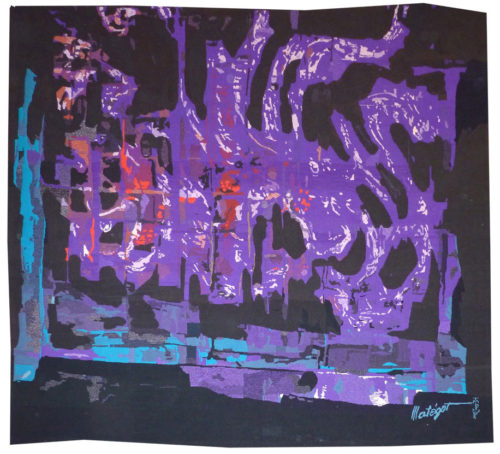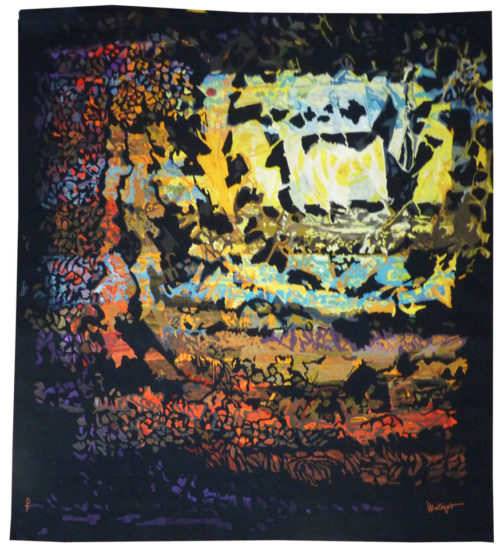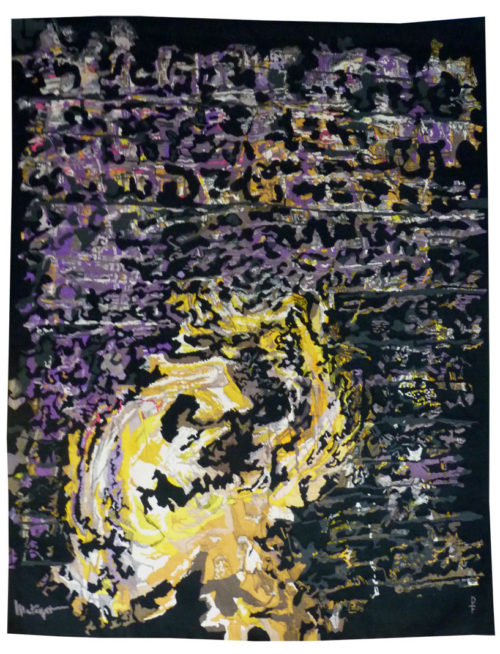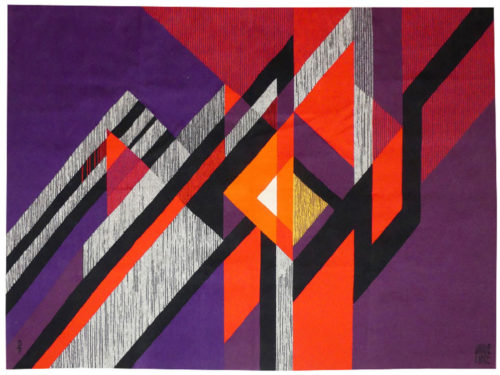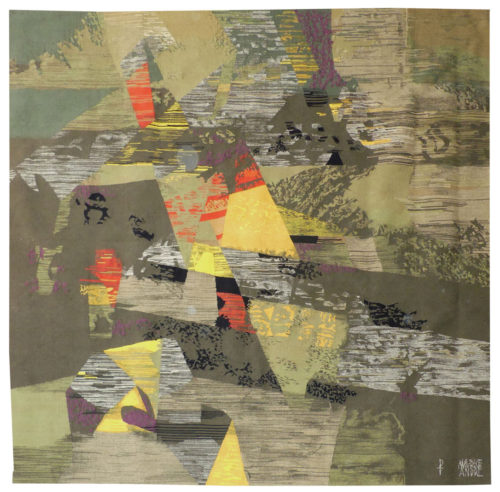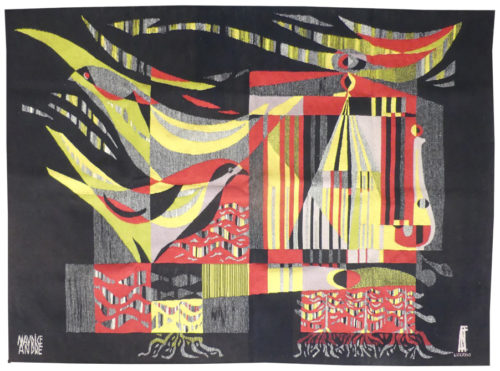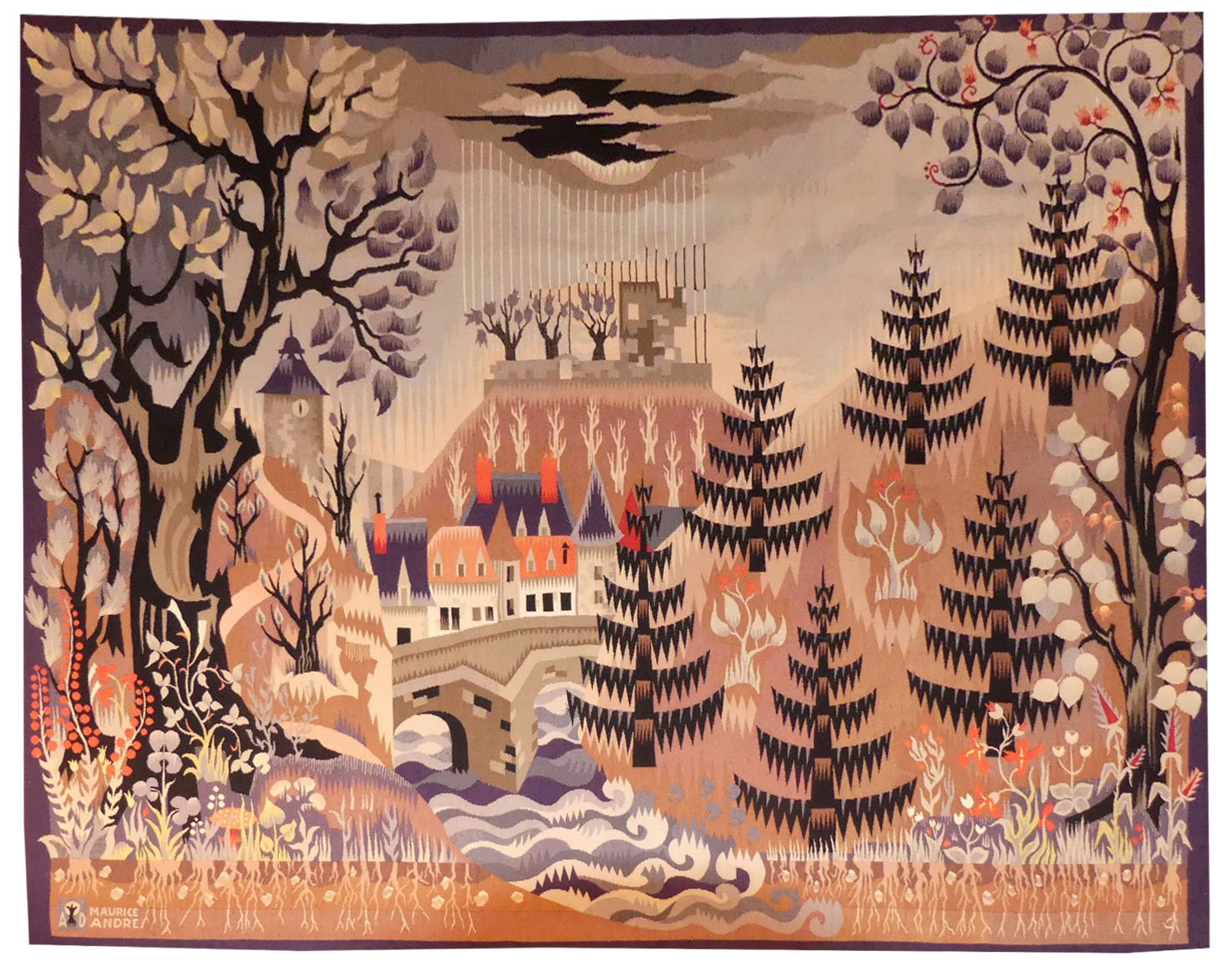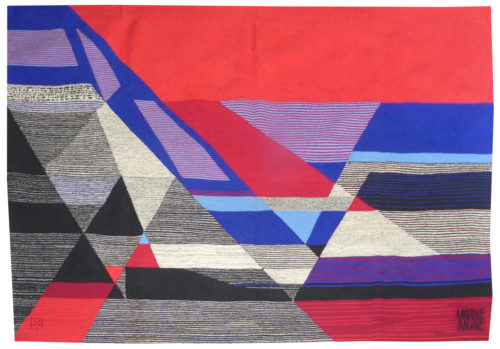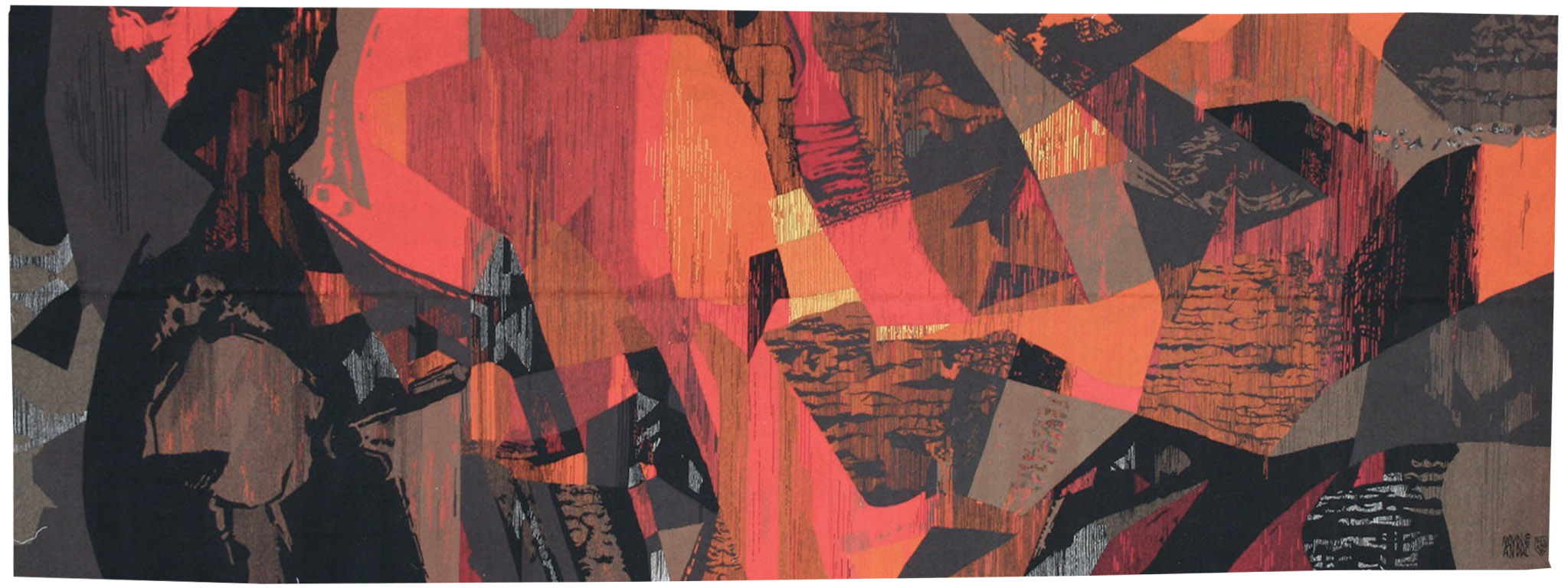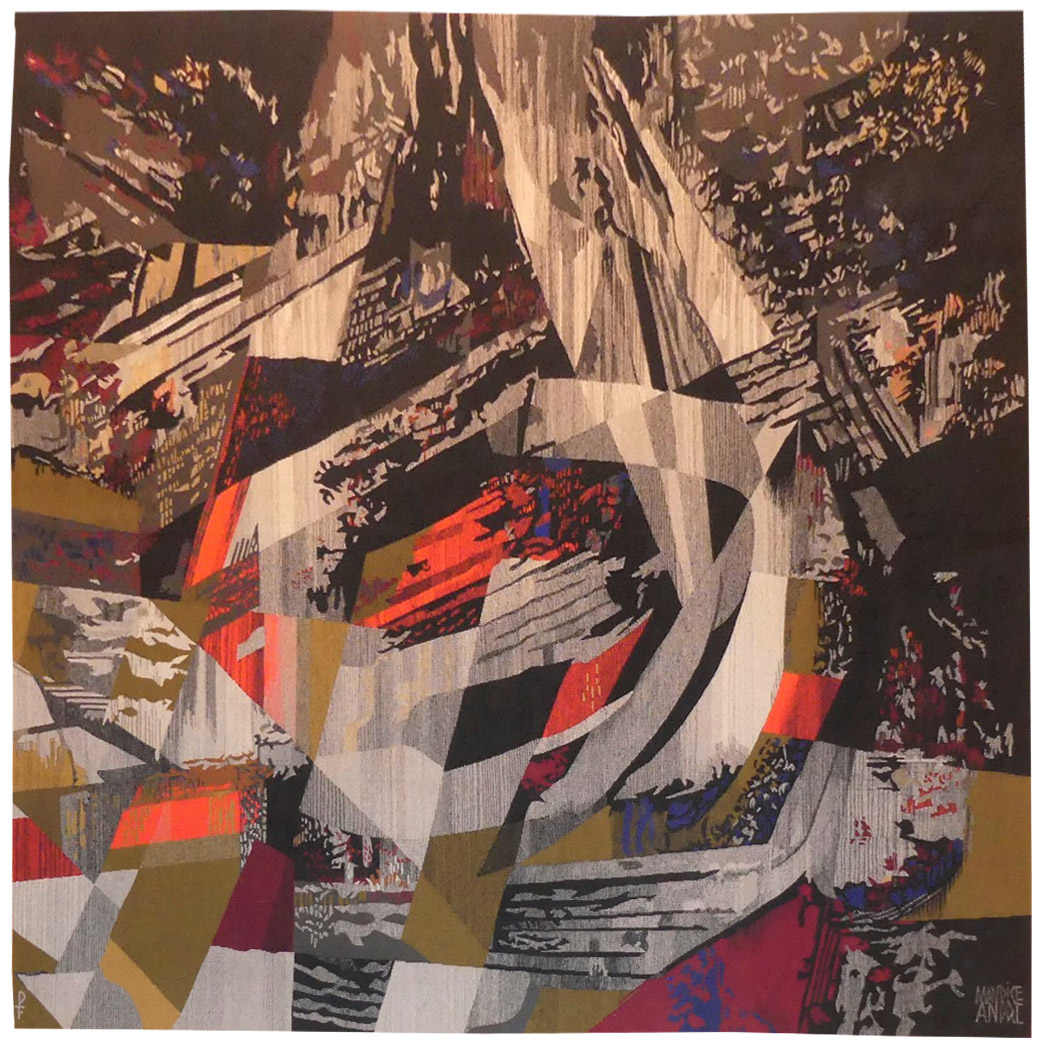-
Soleil carré (square sun)
Aubusson tapestry woven in the Pinton workshop. Complete with certificate of origin signed by the artist, n°EX-A. Circa 1965. Matégot, originally a decorator, then creator of artefacts and furniture (an activity he abandoned in 1959) met François Tabard in 1945 and gave him his first cartoons, first of all figurative then rapidly of abstract design in the 1950’s. He became a member of the A.P.C.T. (Association des Peintres Cartonniers de Tapisserie) in 1949, participated in many international exhibitions (Matégot, like Lurçat before him, was an untiring advocate of the art of tapestry) fulfilled numerous public commissions, sometimes of monumental proportions (“Rouen” 85m2 for the Préfecture of the Seine Maritime département, and also tapestries for Orly Airport, for the Maison de la Radio, for the IMF...) and designed no fewer than 629 cartoons up until the 1970’s. In 1990 the Matégot foundation for contemporary tapestry was inaugurated in Bethesda, U.S.A. Matégot is an artist, like Wogensky, Tourlière or Prassinos, who turns wool textiles resolutely towards the abstract: at first lyrical, geometric in the 70’s, exploiting various technical aspects of the loom : colour graduations, shading, irregularities... « Soleil carré » (Square sun - a contradiction in terms) also illustrates Matégot’s style in the mid-60’s, where shadow and light are in open confrontation : from the upper right hand part of the tapestry the colours radiate outwards dispersing the darkness in concentric fashion. Bibliography : Exhibition catalogue, Matégot, Angers, Musée Jean Lurçat et de la Tapisserie Contemporaine, 1990-1991 Patrick Favardin, Mathieu Matégot, Editions Norma, 2014 -
Dragon dans la nuit (a dragon in the night)
Aubusson tapestry woven in the Pinton workshop. Complete with certificate of origin signed by the artist, n°1/6. Circa 1965. Matégot, originally a decorator, then creator of artefacts and furniture (an activity he abandoned in 1959) met François Tabard in 1945 and gave him his first cartoons, first of all figurative then rapidly of abstract design in the 1950’s. He became a member of the A.P.C.T. (Association des Peintres Cartonniers de Tapisserie) in 1949, participated in many international exhibitions (Matégot, like Lurçat before him, was an untiring advocate of the art of tapestry) fulfilled numerous public commissions, sometimes of monumental proportions (“Rouen” 85m2 for the Préfecture of the Seine Maritime département, and also tapestries for Orly Airport, for the Maison de la Radio, for the IMF...) and designed no fewer than 629 cartoons up until the 1970’s. In 1990 the Matégot foundation for contemporary tapestry was inaugurated in Bethesda, U.S.A. Matégot is an artist, like Wogensky, Tourlière or Prassinos, who turns wool textiles resolutely towards the abstract: at first lyrical, geometric in the 70’s, exploiting various technical aspects of the loom : colour graduations, shading, irregularities... The cartoon is characterised by the habitual contrast of light and shadow, typical of those of this period ; the title, however, conveys a more figurative context, evoking a fantastic beast breathing flames (and indeed illustrated in fire) to disperse the darkness. Bibliography : Exhibition catalogue, Matégot, Angers, Musée Jean Lurçat et de la Tapisserie Contemporaine, 1990-1991 Patrick Favardin, Mathieu Matégot, Editions Norma, 2014 -
Aubusson tapestry woven in the Pinton workshop. N°1/6. Circa 1970.Maurice André settled in Aubusson for the duration of the second world war. A founding member of the group “Tapisserie de France” and a member of the A.P.C.T. (Association des Peintres-Cartonniers de Tapisserie), he developed a personal style, different from that of Lurçat, characterised by rigorous, cubist-influenced flat areas of colour, often using a limited palette ; he received large-scale public commissions for the Council of Europe in Strasbourg (“L’Europe unie dans le Travail et la Paix”) or for the French pavilion at the Brussels Exhibition in 1958 (“La Technique moderne au service de l’Homme”). Gradually (as with Wogensky and Prassinos,...) his style evolved towards more abstraction, firstly lyrical and then more and more geometric, in a way very similar to Matégot. Characteristic of André’s final period, the geometric shapes and flat areas of colour are tempered by hatching, stripes and shading.
-
Vercors
Aubusson tapestry woven by the Pinton workshop. With signed label, n°2/6. Circa 1965.Maurice André settled in Aubusson for the duration of the second world war. A founding member of the group “Tapisserie de France” and a member of the A.P.C.T. (Association des Peintres-Cartonniers de Tapisserie), he developed a personal style, different from that of Lurçat, characterised by rigorous, cubist-influenced flat areas of colour, often using a limited palette ; he received large-scale public commissions for the Council of Europe in Strasbourg (“L’Europe unie dans le Travail et la Paix”) or for the French pavilion at the Brussels Exhibition in 1958 (“La Technique moderne au service de l’Homme”). Gradually (as with Wogensky and Prassinos,...) his style evolved towards more abstraction, firstly lyrical and then more and more geometric, in a way very similar to Matégot. In the mid 1960’s André’s style becomes comparable to that of Matégot, where battage, pick and pick and shading are the norm. Varying shades of green and triangular shapes are the means of evoking the peaks of the Vercors. -
Composition
Maurice André settled in Aubusson for the duration of the second world war. A founding member of the group “Tapisserie de France” and a member of the A.P.C.T. (Association des Peintres-Cartonniers de Tapisserie), he developed a personal style, different from that of Lurçat, characterised by rigorous, cubist-influenced flat areas of colour, often using a limited palette ; he received large-scale public commissions for the Council of Europe in Strasbourg (“L’Europe unie dans le Travail et la Paix”) or for the French pavilion at the Brussels Exhibition in 1958 (“La Technique moderne au service de l’Homme”). Gradually (as with Wogensky and Prassinos,...) his style evolved towards more abstraction, firstly lyrical and then more and more geometric, in a way very similar to Matégot. Always geometric (going as far as pure abstraction in the 1970’s) Maurice André’s style is here limited to a cubic, kaleidoscopic vision : we can distinguish birds, roots, waves and perhaps a cage, …, all themes that can also be found in Lurçat’s work.Aubusson tapestry woven in the Tapisseries de France workshop. Circa 1960. -
Aubusson
Aubusson tapestry woven in the Andraud-Dethève workshop. 1943.Maurice André settled in Aubusson for the duration of the second world war. A founding member of the group “Tapisserie de France” and a member of the A.P.C.T. (Association des Peintres-Cartonniers de Tapisserie), he developed a personal style, different from that of Lurçat, characterised by rigorous, cubist-influenced flat areas of colour, often using a limited palette ; he received large-scale public commissions for the Council of Europe in Strasbourg (“L’Europe unie dans le Travail et la Paix”) or for the French pavilion at the Brussels Exhibition in 1958 (“La Technique moderne au service de l’Homme”). Gradually (as with Wogensky and Prassinos,...) his style evolved towards more abstraction, firstly lyrical and then more and more geometric, in a way very similar to Matégot. « Aubusson », Maurice André’s first tapestry cartoon, illustrates both how he adheres to Lurçat’s principles of technique (counted threads, large flat areas of colour...) and how his aesthetic can be seen to be different (as it is from Gromaire’s own treatment of the same subject some years earlier). His closest influence at the time is in fact Dubrueil, his father-in-law, his own stylistic emancipation would come a little later. The historical importance of the cartoon is undeniable : it is one of the rare illustrations of the town (even more synthesised than Gromaire’s version) at a time when the Tapestry Renaissance was in its infancy. -
Linéaire (Linear)
Maurice André settled in Aubusson for the duration of the second world war. A founding member of the group “Tapisserie de France” and a member of the A.P.C.T. (Association des Peintres-Cartonniers de Tapisserie), he developed a personal style, different from that of Lurçat, characterised by rigorous, cubist-influenced flat areas of colour, often using a limited palette ; he received large-scale public commissions for the Council of Europe in Strasbourg (“L’Europe unie dans le Travail et la Paix”) or for the French pavilion at the Brussels Exhibition in 1958 (“La Technique moderne au service de l’Homme”). Gradually (as with Wogensky and Prassinos,...) his style evolved towards more abstraction, firstly lyrical and then more and more geometric, in a way very similar to Matégot. Always geometric (going as far as pure abstraction in the 1970’s) Maurice André’s style is here limited to a cubic, kaleidoscopic vision : we can distinguish birds, roots, waves and perhaps a cage, …, all themes that can also be found in Lurçat’s work.Aubusson tapestry woven in the Picaud workshop. With signed label. 1974. -
Le soleil d'Apremont (the sun of Apremont)
Aubusson tapestry woven in the Picaud workshop. With signed label, n°1/4. Circa 1965.Maurice André settled in Aubusson for the duration of the second world war. A founding member of the group “Tapisserie de France” and a member of the A.P.C.T. (Association des Peintres-Cartonniers de Tapisserie), he developed a personal style, different from that of Lurçat, characterised by rigorous, cubist-influenced flat areas of colour, often using a limited palette ; he received large-scale public commissions for the Council of Europe in Strasbourg (“L’Europe unie dans le Travail et la Paix”) or for the French pavilion at the Brussels Exhibition in 1958 (“La Technique moderne au service de l’Homme”). Gradually (as with Wogensky and Prassinos,...) his style evolved towards more abstraction, firstly lyrical and then more and more geometric, in a way very similar to Matégot. In the mid 1960’s André’s style becomes comparable to that of Matégot, made of lyrical ensembles of triangular shapes, in a homogenous colour scheme and sprinkled with stripes, stains, marks... often black, where different techniques specific to the weaver’s art are used to accentuate the impression of volume and depth. -
Nuit sidérale (astral night)
Aubusson tapestry woven in the Pinton workshop. With label. Circa 1965.Maurice André settled in Aubusson for the duration of the second world war. A founding member of the group “Tapisserie de France” and a member of the A.P.C.T. (Association des Peintres-Cartonniers de Tapisserie), he developed a personal style, different from that of Lurçat, characterised by rigorous, cubist-influenced flat areas of colour, often using a limited palette ; he received large-scale public commissions for the Council of Europe in Strasbourg (“L’Europe unie dans le Travail et la Paix”) or for the French pavilion at the Brussels Exhibition in 1958 (“La Technique moderne au service de l’Homme”). Gradually (as with Wogensky and Prassinos,...) his style evolved towards more abstraction, firstly lyrical and then more and more geometric, in a way very similar to Matégot. In the mid 1960’s André’s style becomes comparable to that of Matégot, where battage, pick and pick and shading are the norm. By its theme, its technique, its colour scheme, its format, this particular cartoon is close to « Grand nocturne » copies of which are to be found at the Musée Jean Lurçat and the musée de la tapisserie contemporaine in Angers.


